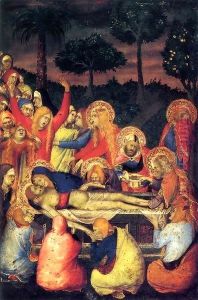Simone Martini and Lippo Memmi Paintings
Simone Martini was an Italian painter born in Siena, widely regarded as one of the key figures in the development of early Italian painting and one of the leading masters of the Sienese School. His exact birth date isn't known, but it is traditionally cited as circa 1284. Martini was a contemporary and possibly a pupil of the renowned artist Duccio di Buoninsegna, under whose influence he developed his own distinctive style, characterized by elegant figures, an ornate use of line, and a delicate handling of color and detail.
Simone Martini's most famous work is the 'Maestà', commissioned for the Palazzo Pubblico, Siena's town hall, which he completed in 1315. This was a large altarpiece that established his reputation and became a model for other Sienese painters. Another significant contribution of Martini was his work in the Basilica of San Francesco in Assisi, where he painted several frescoes that are celebrated for their grace and sophistication.
In 1339, Martini went to the Papal court in Avignon, where he worked until his death in 1344. His work there included the fresco of 'St. Martin of Tours' and the exquisite 'Annunciation with St. Margaret and St. Ansanus', now in the Uffizi Gallery, which he signed with his brother-in-law and fellow painter Lippo Memmi, indicating a collaborative effort. Martini’s influence extended to the International Gothic style, and his refined courtly aesthetic had a lasting impact on European art.
Lippo Memmi, whose full name was Filippo di Memmo di Filippuccio, was an Italian painter from Siena active during the early 14th century. His birth date is uncertain, but he was likely born in the late 13th century. Memmi is traditionally believed to have been a student and brother-in-law of Simone Martini, having married Martini's sister. This connection significantly shaped his artistic development and career.
Memmi's work is often closely associated with that of Martini; in fact, for many years, art historians had difficulty distinguishing between the works of the two artists. It is believed that Memmi worked alongside Martini on several projects, including possibly the 'Annunciation' in the Uffizi Gallery and other commissions in Siena and Avignon. Memmi's own style was deeply influenced by Martini's elegance and attention to detail, although he never quite achieved the same level of acclaim and innovation as his more famous relative.
Memmi's most notable independent work is the 'Maestà' in the Palazzo Comunale of San Gimignano, which bears a strong resemblance to Martini's 'Maestà' in Siena. His other significant contributions include a large 'Crucifixion' scene and several Virgin and Child images that reflect the tender and refined characteristics of the Sienese School. The exact date of Memmi's death is not precisely recorded, but he is believed to have died sometime after 1347. Together, Martini and Memmi's works mark an important chapter in the history of Italian Gothic painting.
